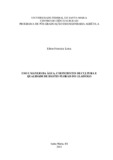| dc.creator | Lima, Elton Ferreira | |
| dc.date.accessioned | 2021-12-13T13:05:27Z | |
| dc.date.available | 2021-12-13T13:05:27Z | |
| dc.date.issued | 2021-02-22 | |
| dc.identifier.uri | http://repositorio.ufsm.br/handle/1/23263 | |
| dc.description.abstract | Knowledge of the water consumption of a crop throughout its cycle is essential for good irrigation management and to ensure maximum productivity. Thus, the objectives in this dissertation were: (i) Evaluate the effects of irrigation and cultural remains on the quality of the floral stems of the gladiolus; (ii) to determine the evapotranspiration (ETc) and the crop coefficients of the gladiolus in planting systems with and without soil mulching and ; (iii) fractionate the ETc in transpiration of the crop (Tc) and evaporation of the soil (Es), deriving the coefficient of basal culture (Kcb) and evaporation (Ke). Two field experiments were carried out with two gladiolus cultivars, two planting systems (with mulching and without mulching) and two water regimes (with irrigation and without irrigation). In both experiments, plant height, soil cover fraction by crop, leaf área, and leaf area index were evaluated. The water content in the soil was monitored for the purpose of irrigation management and simulation of the soil water balance. The soil water balance model - SIMDualKc was used to estimate the ETc of the crop, fractioning it in the Es and transpiration components of the Tc plant. The results showed that the soil cover with straw did not influence the quality of flower stems of the gladiolus. Irrigation contributes to increasing the quality of floral stems of the gladiolus, providing greater plant height, longer spike length, larger stem diameter and a greater number of florets per spike. Among cultivars, only the length of the spike showed significant differences. The SIMDualKc model was calibrated and validated for gladiolus. The mean initial and final Kcb values calibrated by the model were: 0.20, 0.50 and 0.50. ETc showed differences between cultivars in different treatments, ranging from 265 to 301 mm. Es represents an important fraction of the ETc throughout the gladiolus cycle, especially when the soil is not covered, being an important parameter to be considered in the management of gladiolus irrigation. | eng |
| dc.description.sponsorship | Coordenação de Aperfeiçoamento de Pessoal de Nível Superior - CAPES | por |
| dc.language | por | por |
| dc.publisher | Universidade Federal de Santa Maria | por |
| dc.rights | Attribution-NonCommercial-NoDerivatives 4.0 International | * |
| dc.rights.uri | http://creativecommons.org/licenses/by-nc-nd/4.0/ | * |
| dc.subject | Requerimento hídrico | por |
| dc.subject | Transpiração da cultura | por |
| dc.subject | Evaporação | por |
| dc.subject | Irrigação | por |
| dc.subject | SIMDualKc | por |
| dc.subject | Water requirement | eng |
| dc.subject | Perspiration of crop | eng |
| dc.subject | Evaporation | eng |
| dc.subject | Irrigation | eng |
| dc.title | Uso e manejo da água, coeficientes de cultura e qualidade de hastes florais do gladíolo | por |
| dc.title.alternative | Water use and management, crop coefficients and quality of gladiol flower stems | eng |
| dc.type | Dissertação | por |
| dc.description.resumo | O conhecimento do requerimento hídrico de uma cultura ao longo do seu ciclo é crucial para um melhor manejo da irrigação e garantir a máxima produtividade. Assim, os objetivos dessa dissertação foram: (i) Avaliar os efeitos da irrigação e restos culturais na qualidade das hastes florais do gladíolo; (ii) determinar a evapotranspiração (ETc) e os coeficientes de cultura do gladíolo em sistemas de plantio com e sem cobertura do solo com palha e; (iii) fracionar a ETc em transpiração da cultura (Tc) e evaporação do solo (Es), derivando o coeficiente de cultura basal (Kcb) e de evaporação (Ke). Foram realizados dois experimentos de campo com duas cultivares de gladíolo, dois sistemas de plantio (com palha e sem palha) e dois regimes hídricos (com irrigação e sem irrigação). Em ambos os experimentos foram avaliados a altura de plantas, fração de cobertura do solo pela cultura, área foliar e índice de área foliar. O conteúdo de água no solo foi monitorado para fins do manejo da irrigação e simulação do balanço hídrico do solo. O modelo do balanço hídrico do solo – SIMDualKc foi utilizado para estimar a ETc da cultura, fracaionando-a nos componentes de Es e transpiração da planta Tc. A cobertura do solo com palha não influenciou a qualidade de hastes florias do gladíolo. A irrigação possibilitou o aumento da qualidade de hastes florais do gladíolo, proporcionando maior altura de plantas, maior comprimento do pendão, maior diâmetro da haste e maior número de floretes por haste. Entre cultivares, apenas o comprimento do pendão apresentou diferenças significativas. O modelo SIMDualKc foi calibrado e validado para a cultura do gladíolo. Os valores de Kcb inicial médio e final calibrados pelo modelo foram: 0,20, 0,50 e 0,50. A ETc apresentou diferenças entre as cultivares nos diferentes tratamentos, variando de 265 a 301 mm. A Es representa uma fração importante da ETc da cultura do gladíolo durante todo o ciclo da cultura, especialmente quando o solo não tem cobertura, sendo um importante parâmetro a ser considerado na gestão da irrigação do gladíolo. | por |
| dc.contributor.advisor1 | Streck, Nereu Augusto | |
| dc.contributor.advisor1Lattes | http://lattes.cnpq.br/8121082379157248 | por |
| dc.contributor.advisor-co1 | Petry, Mirta Teresinha | |
| dc.contributor.referee1 | Uhlmann, Lilian Osmari | |
| dc.contributor.referee2 | Silva, Wilson Araújo da | |
| dc.creator.Lattes | http://lattes.cnpq.br/4021293213164978 | por |
| dc.publisher.country | Brasil | por |
| dc.publisher.department | Engenharia Agrícola | por |
| dc.publisher.initials | UFSM | por |
| dc.publisher.program | Programa de Pós-Graduação em Engenharia Agrícola | por |
| dc.subject.cnpq | CNPQ::CIENCIAS AGRARIAS::ENGENHARIA AGRICOLA | por |
| dc.publisher.unidade | Centro de Ciências Rurais | por |



